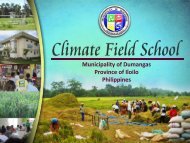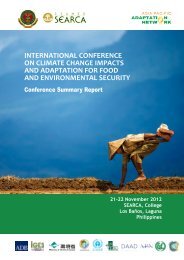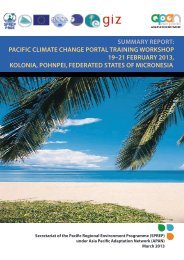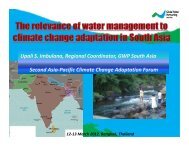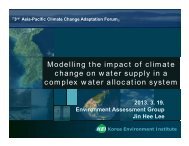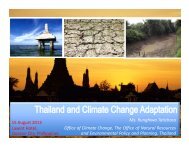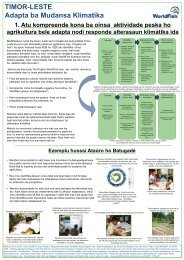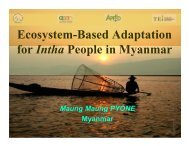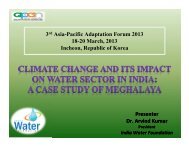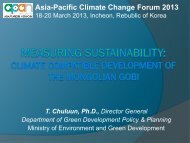Sri Lanka
Sri Lanka
Sri Lanka
You also want an ePaper? Increase the reach of your titles
YUMPU automatically turns print PDFs into web optimized ePapers that Google loves.
Water Security Progress and<br />
Success Stories<br />
R.P.M. Dissanayake<br />
Deputy Director<br />
Irrigation Management Division<br />
Ministry of Irrigation & Water Resources Management
Annual Rainfall & Climatic Zones<br />
Below 1750mm<br />
2500mm ‐5000mm<br />
1750mm‐2500mm<br />
Mean annual rainfall<br />
1861mm
Water Availability<br />
• Surface water 43000-45000 MCM<br />
• Ground water 7800 MCM<br />
• Per Capita Water Availability 2260 CM<br />
• According to UN standards, per capita water availability<br />
in <strong>Sri</strong> <strong>Lanka</strong> is at an adequate level.<br />
• However, <strong>Sri</strong> <strong>Lanka</strong> experiences water scarcity due to<br />
spatial and temporal variations in rainfall pattern<br />
• Such water scarcities are overcome to some extent by<br />
trans basin diversions.
Sectoral Water Usage in <strong>Sri</strong> <strong>Lanka</strong><br />
Sector 1990 2000 2009<br />
Irrigation 96% 90% 83%<br />
Domestic 2% 7% 7%<br />
Industry & Others 2% 3% 10%<br />
120%<br />
100%<br />
80%<br />
60%<br />
40%<br />
20%<br />
Irrigation<br />
Domestic<br />
Industry&Others<br />
0%<br />
1990 2000 2009
Water Security<br />
Household<br />
water security<br />
Economic<br />
water security<br />
Water related<br />
disaster<br />
security<br />
National<br />
water<br />
security<br />
Urban water<br />
security<br />
Environmental<br />
water security
Some Enabling Factors<br />
• A Water Heritage *(hydraulic civilization spanning 2500 years)<br />
• Reservoir Cascades (highest density in the world)<br />
• Electrification (85% coverage)<br />
• * “Let not a drop of water go to the sea without first being of use<br />
to man” King Parakramabahu the Great‐ AD 1153‐1186
Household Water Security<br />
• Safe water coverage 88%<br />
• Pipe borne water availability 43.5%<br />
• Protected dug wells 31.5 %<br />
• Tube wells and hand pumps 9 %<br />
• Rain water harvesting and others 4 %<br />
• Sanitation coverage 86%<br />
Pipe borne water availability<br />
Protected dug wells<br />
Tube wells and hand pumps<br />
Rain water harvesting and others
Household Water Security Progress and Success Stories<br />
• Government Policy Framework for 2010-2020, provides for pipe-borne<br />
water facilities are to be increased to 60% and safe water to 100%by 2020<br />
• Sanitation is always linked to household water, increased level to<br />
sanitation with government grants/support for r building toilets to low<br />
income rural and urban families.<br />
• Bringing behavioral changes and promoting better hygienic practices<br />
among user communities through effective awareness programs have<br />
decreased water related deceases.<br />
• Private sector and NGOO are engaged in sanitation advocacy and<br />
promotion activities<br />
• Government has adopted a Rainwater Harvesting Policy in 2005 ,reducing<br />
burden on pipe-borne water.<br />
• Capacity building of CBOs to manage their own water resources - 2500<br />
CBOs involved in construction, operation and maintenance community<br />
water supply schemes. 30% national coverage.
Economic Water Security Progress<br />
Water use for agriculture 83%<br />
Rain fed water 20%<br />
Irrigated water 78%<br />
Ground water 2%<br />
Irrigation tanks and anicuts in <strong>Sri</strong> <strong>Lanka</strong><br />
Type of Irrigation Major Medium Minor<br />
scheme<br />
Tank 69 152 10000<br />
Anicuts/wiers 33 78<br />
Estimated total irrigation water volume 7000 MCM<br />
Water usage for industries 7%<br />
Water used for hydro power generation 24%(reused for agriculture &<br />
other purposes)
Economic Water Security Progress and Success Stories<br />
• Trans-basin diversions are multipurpose carrying nearly2250 MCM to<br />
be increased to more than 2500 MCM in near future. Nearly 70% of<br />
crop water ET requirement of Anuradhapura and Polonnaruwa Districts<br />
are provided through such diversions.<br />
• A cascade system of storage d from historical times secures irrigation<br />
and livelihood, ground water recharge and environmental needs.<br />
• Government has initiated14 water resources development projects to<br />
harness the optimum use of surface and ground water.<br />
• Rehabilitation and modernization of irrigation infrastructure is<br />
undertaken to Increase water use efficiency.<br />
• Bulk water is issued for industrial sector.<br />
• Improved water management techniques and practices are adopted (<br />
real time monitoring-MASL) for sharing water with other sectors<br />
(drinking & industrial).<br />
• Farmer capacity is increased for community participation in irrigation<br />
management .<br />
• Introduction of crop varieties and technologies to Increased water<br />
productivity & minimize water usage for agriculture.
OFC
Maintenance
Urban Water Security Progress and Success Stories<br />
• 89% of the total population is provided with pipe‐borne water to<br />
urban areas; 3% use deep wells and 8% use shallow wells.<br />
• 32% of industrial waste water is treated and released to<br />
environment.<br />
• At present pipe‐borne sewerage covers 3%; it is expected to expand<br />
up to 7% by 2020 in urban areas.<br />
• We do not have secure storage of rain water to supply urban water<br />
requirements; cultural barriers/ inhibitions are constraints to use of<br />
collected water for drinking.<br />
• Government has plans to construct 14 major water supply projects to<br />
increase water supply in main townships by 2020.<br />
• Challenge‐Low waste water management practices. Cultural<br />
barriers to use of treated waste water.
Environmental Water Security Progress<br />
and Success Stories<br />
• Historical and traditional environmentally friendly cultural practices<br />
bound with minimum disturbance to the watershed.<br />
• Illegal expansion /encroachment in agriculture in hilly areas have<br />
negatively impacted on main watersheds of the country.<br />
• Effort to mitigate the negative effects to the watersheds through legal<br />
institutional and administrative means.<br />
• Watershed Management Policy was accepted by government in 1994.<br />
• In 1980, government passed the National Environment Act ,again<br />
revised in 2000 to strengthen the legal framework for sustainable<br />
environment management<br />
• Environmental aspects when constructing irrigation facilities (fish<br />
ladders, maintaining minimum water flow , animal crossings etc)<br />
• EIA and SIA process is followed to minimize adverse environmental<br />
effects.<br />
• Tank and Anicut (wier) system built throughout the country support<br />
agriculture and environment; historically some of these tanks were built<br />
to conserve water only for ground water recharge and environmental<br />
purposes.
Cascade System
Resilience to Water Related Disasters<br />
• <strong>Sri</strong> <strong>Lanka</strong> now experience s more water related disasters than in the past<br />
specially flood and earth slips / land slides.(climate variability)<br />
• Mostly floods are encountered at the low level plains and earth slips/land<br />
slides occur in hilly areas of the country.<br />
• To secure water related disasters government has taken following remedial<br />
actions.<br />
• Established Disaster Management Ministry and Disaster Management<br />
Centre with District and Divisional Coordinating Officers.<br />
• Expansion of the meteorological activities island wide.<br />
• Improved information exchanging and data sharing mechanisms.<br />
• Evacuation of the people in vulnerable areas.<br />
• Emergency relief services expanded.
Floods<br />
Earth slips
Threats and Challenges<br />
1. Water pollution<br />
• over usage of agrochemicals and fertilizer<br />
• Unauthorized release of effluents to the water bodies by industrial<br />
sector .<br />
• Poor solid waste management by local authorities.<br />
• Dumping of garbage to water courses.<br />
• Direct discharge of untreated sewage by households to waterways.<br />
2. Though there is a high potential for rain water harvesting<br />
for drinking water purposes, our cultural limitations<br />
restricts this.<br />
3. Build up sectoral water harmony.




